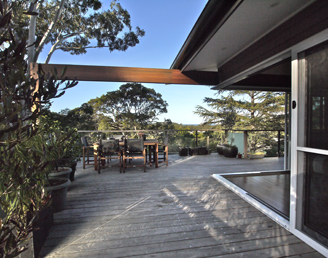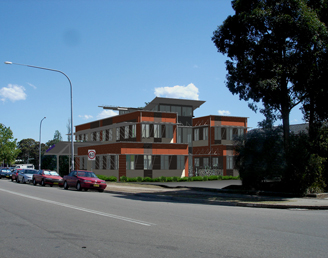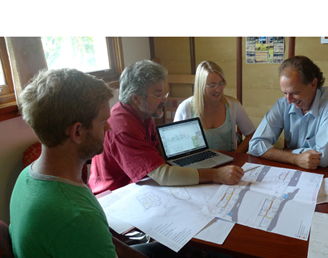Travel broadens the mind
Posted by admin on 02/08/2013 at 6:47 amTravel broadens the mind – and help makes good architecture
They say travel broadens the mind, and it is undeniably true. They also say that a change is as good as a holiday, but I am not so sure that’s totally true. Then again, they also say chilli brings out the flavour of other ingredients, and that’s completely untrue: ask any flavour physiologist or taste bio-chemist – they will tell you its only action is to attack the pain receptors on the tongue, thus actually deadening sensory perception of other subtle flavours, but I digress. Although there is a connection, but more on that later.

JAMES PRICE POINT, LOOKING SOUTH TOWARDS WALMADAN, WHERE THE GAS HUB NEARLY WAS
I have just returned from a month in the beloved Kimberley, WA. This was not a shallow attempt at escaping a Sydney winter, although that was a nice side effect. It was originally timed to coincide with the ultimate threat to the pristine coastline of the Dampier Peninsula, but Woodside’s decision not to proceed with on-shore processing of the Browse Basin gas has given James Price Point a temporary reprieve. Thus the trip was able to focus on learning rather than activism.
Which is where perspective comes into it.

CAMP AT YELLOW RIVER, 80km NORTH OF BROOME
How do we look at what we do as a civilisation, if not through an external lens? How does a goldfish get a sense of its bowl if it cannot step outside its own frame of reference? Or at least, project itself outside and look back in? Ok, so goldfish struggle with existentialism (so do many people for that matter – but not you, dear reader!). Humans always wrestle with questions of purpose and destiny – it is simply a human thing to do. But we can also look more closely at the things we design and build, and ask of them ‘why do you exist? – for what purpose were you made? – do you actually work?’
Why did you put that shirt on this morning? Why do travel to work that way? Why did you paint the house that colour? In fact, why do you live in that house at all?
While in the Kimberley, we walked the Lurijarri Heritage Trail with the Goolarabooloo Community. This is a traditional songline that starts on Cable Beach, amongst the tourists and 4WDs, and runs 80km up the coast past James Price Point, to Yellow River. This songline, like all Aboriginal dreaming trails, contains and is linked to all the knowledge in the culture. It has a base level of geographical information (what’s where and how to navigate from point A to point B, including out to neighbouring country and beyond), overlaying this, yet intertwined with it, are the historical and spiritual stories (where they came from), and the moral stories (how to live properly in community), and how to treat others, including how to travel and how to receive and welcome travellers.

PHILLIP ROWE (ON RIGHT), LAW BOSS FOR THE GOOLARABOOLOO MOB
Thanks to benign climate, and the necessary transience of farming a large area (for crops and grazing animals – yes “farming” is the correct term – see earlier posts on The Biggest Estate on Earth by Prof. Bill Gammage) the original inhabitants of the Dampier Pensinsula did not build houses. So what can we possibly learn about architecture from a reputedly nomadic culture, that prior to the 20th century never built things?
Heaps.
For a start, they were never nomadic, they just owned a farm that was so large you had to keep moving around it to keep it all working properly, using the six seasons and fire to farm in similar ways to how Europeans used ploughs and fences.
At a deeper level, having that kind of understanding of the seasons, and of the detailed topography, flora and habits of the fauna, tells us so much of what we need to know BEFORE WE EVEN START sketching.
A successful building is one which responds like an attentive lover to what nature is doing. It makes use of what is on offer, drawing on the laws of physics and what the weather on the day is doing. It rises from the earth carrying its DNA in the colours and textures of its bones, or perhaps floats above it like a shrub bathed in sunshine yet providing shade and shelter beneath. Biophilic design is based upon the innate tendency to focus on life and life like processes – this is what underlies good architecture.

JAMES PRICE POINT – RED PINDAN, WHITE SAND

WHITE BELLIED SEA EAGLE – PERFECT DESIGN?
You think perhaps I have listened to too many of Kevin Mccleod’s closing voice-overs on Grand Designs? Amusing thought, but no – these are the things that underlie great architecture.
But here is the counter-perspective: great architecture at any scale can never make us happy.
If your love life has turned to bog, if your kids are on drugs, if your have lost your job, if bombs are going off in the street – no amount of wonder and grace in any building is going to put things right. And if any house-obsessed client says to their designer “this is the house of my dreams, it will make my life complete!” then they are in la-la land and will never find happiness if that’s where they think it lives. Alain de Botton has a lot to say about this in The Architecture of Happiness. Well worth a read for anyone who feel twinges of house-obsessiveness. Likewise there are lots of loving happy balanced families living in truly awful buildings. Because love is the most important thing, probably in the whole universe. I means, oxygen is good, but love…!

“DON’T CRY, I LOVE YOU”
One more thing I was strongly reminded of by the Goolarabooloo mob – the truth in the old saying ‘it takes a village to raise a child’. One of the most precious things about the Kimberley is the number of functional and intact Aboriginal communities. Forget The Intervention – these guys could write the text book on how to make community work. When we design houses and villages and whole neighbourhoods, nowadays we do try to encourage community involvement and cohesion, and if not, then it’s a really crap design! But it will only work if we have the desire to see the village come together, to belong to an open tribe and to work for its general well-being.

EXPERT THROW

KIDS JUST BEING KIDS

MUNGA (NATIVE HONEY), SERVED WITH A SMILE

TERRENCE HUNTER JR, STORY TELLER
More info on the Lurijarri Heritage Trail here, and you be friends with the Goolarabooloo mob on that Facebook time-wasting thing here.
Sustainable House Design
We will help you create a family home that works well, feels good, is kind to the environment, culturally appropriate and reduces your energy and running costs.
Read MoreSustainable Commercial Buildings
We design your building to help reduce your operating costs, optimize the life cycle of your building, increase your property value and increase employee productivity.
Read MoreWorking with Envirotecture
We design beautiful, sustainable buildings that work for you, your family or your business. Full range of building design, consulting and training services.
Read More






















